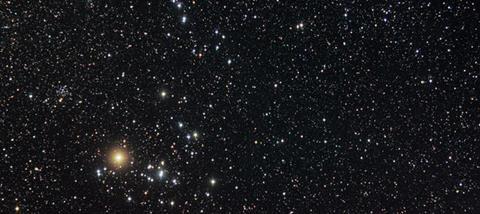
The visitation of the magi carries a ring of truth.
Because astrology was condemned by the early church as demonic, it seems rather unlikely that the early Christians would have invented astrologers to be the primary visitors, and worshippers, of the baby Jesus shortly following his birth.
According to Matthew’s gospel, the magi from the east were guided by a star that came to rest over the birthplace of Jesus (Matthew 2:9). Not much is made of the star of Bethlehem in the New Testament. In modern times, various attempts have been made to explain the star in terms of astronomical phenomena. Here are three possibilities:
1. A Conjunction of Planets
In 1595, German astronomer Johannes Kepler discovered the periodic conjunction of Saturn and Jupiter. Planetary conjunctions occur when two or more planets appear, from our earthbound perspective, to approach each other before separating again.
Kepler argued that the star of the magi, rather than being a single celestial body, was actually a conjunction of Saturn and Jupiter that occurred in the constellation of Pisces in the year 7 BC. Kepler showed that, in 7 BC a rare triple conjunction of these planets took place. As Pisces is said to symbolize Jewishness, it is argued that the Magi would have interpreted this occurrence as signifying some event of Jewish importance.
However, there are significant problems with this theory. For one thing, the star by which the Magi were guided must have directed their paths for at least several weeks. Yet, none of these planetary conjunctions would have lasted for more than a few days. Arthur C. Clarke, in his book Report on Planet Three identifies a further problem with Kepler’s theory:
‘Better calculations than those [Kepler] was able to make in the seventeenth century have shown that this particular conjunction was not a very close one, and the planets were always far enough apart to be easily separated by the eye. Moreover, there was a closer conjunction in 66 BC, which on Kepler’s theory should have brought a delegation of wise men to Bethlehem sixty years too soon!’
The planetary conjunction explanation of the star of the magi thus seems to me to be rather less than plausible.
2. A Comet
In the late second century, the early Christian theologian Origen proposed that the star of the magi might be a comet.
In a paper published in the Quarterly Journal of the Royal Astronomical Society in 1991, British physicist Colin J. Humphreys defended the idea that the star of the magi was in fact a comet (Q. Jl R. astr. Soc., 1991, 32, 389-407). He argued that ‘an examination of historical records shows that comets were interpreted as heralding both good and bad major events, in particular the births and deaths of kings and important victories or defeats in wars.’
The theory that the star of the magi was a comet has been defended more recently by Colin Nicholl, in his 2015 book, The Great Christ Comet – Revealing the True Star of Bethlehem.
3. An Angelic Presence?
One alternative idea is that the star of the magi was some angelic presence, or even some other supernatural phenomena.The Christian who subscribes to a worldview that includes the supernatural need not necessarily subscribe to any naturalistic explanation of the Bethlehem star.
Conclusion
There are some other alternative ideas including the hypothesis that the astronomical phenomenon resulted from a nova or from a supernova. If one is to subscribe to some naturalistic hypothesis, then I would suggest that the comet hypothesis seems to be the most plausible.
There might be no naturalistic explanation of the star of the magi, and it may instead be the result of supernatural phenomena. But whatever the explanation, we can rejoice that God has broken into human history in the person of Jesus Christ, and made himself known at an intimate level to mankind.
Jonathan McLatchie is a Christian writer, international speaker and debater. He holds a BSc (with Honors) in Forensic Biology, a Master’s degree in evolutionary biology, a second Master’s degree in medical and molecular bioscience, and is currently a PhD student in cell biology
To receive a free copy of Premier Christianity magazine click here
























